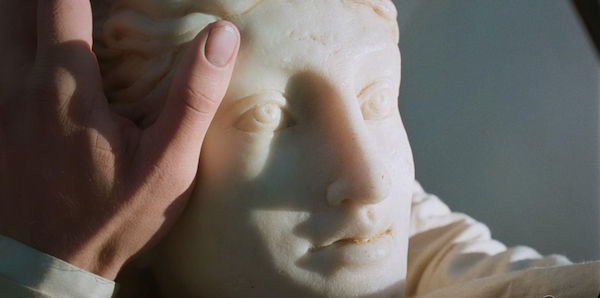Movie review by Greg Carlson
Now available to stream following a quiet and disappointing North American theatrical release, filmmaker Alice Rohrwacher’s “La Chimera” should not be missed. Josh O’Connor, whose recent work for another Italian director in “Challengers” has been more widely seen, gives an equally compelling performance alongside a supporting cast worthy of Fellini. Expanding the remarkably personal storytelling developed since feature narrative debut “Heavenly Body” in 2011 – and perfected in 2018’s sublime “Happy as Lazzaro” – Rohrwacher stakes a serious claim as one of today’s most vital auteurs.
Set in the early 1980s in Riparbella, Tuscany, “La Chimera” begins with an enigmatic reverie on a train. O’Connor’s foreigner Arthur, having recently finished serving a short prison sentence for his part in a group of gravesite thieves (known as tombaroli) who loot Etruscan antiquities, drifts in and out of consciousness as he imagines the face of once-upon-a-time love Beniamina (Yile Vianello). More than a bit rough around the edges, Arthur’s somewhat soiled, cream-colored linen suit and slightly disreputable air (not to mention his pungent odor) call to mind the rakish Jean-Paul Belmondo of “Breathless” as he draws attention from curious fellow passengers.
Arthur accepts the warm hospitality offered by Beniamina’s mother Flora (Isabella Rossellini, a living reminder of Italian cinematic heritage), who holds court with her daughters and a curious caretaker/servant/student named, with symbolic gravitas, Italia (Carol Duarte) in a rapidly deteriorating villa. Far from the opulence of the well-kept mansion played by Northamptonshire’s Drayton House in Emerald Fennell’s “Saltburn,” Flora’s once spectacular keep is closer in cinematic presence to London’s Debenham House as immortalized in Joseph Losey’s “Secret Ceremony.” In all three cases, each dwelling serves as a crucial nexus for our understanding of the story. Later, Rohrwacher will relocate her characters to an abandoned train station, underlining her point.
A walking contradiction, Arthur falls back in with the tombaroli even while he begins to develop romantic feelings for Italia. We learn that Arthur has previously studied archeology, although the filmmaker deliberately withholds any clues regarding her protagonist’s moral philosophy with regard to disturbing and profiting from necropolis treasures (beyond hints that the loss of Beniamina has caused a major change). Throughout “La Chimera,” Rohrwacher relies on the brilliant images collected by cinematographer Hélène Louvart, who mixes and matches a variety of film gauges and stocks to capture the shifting moods among the ruins.
It’s tempting and all too easy to thematically reduce “La Chimera” to a fable about the conflict between perceptions of a glorious, elusive past and the harsher realities of a more mundane and cruel present. Arthur’s gifts with a divining rod additionally situate him as a kind of oracular presence who can, in effect, magically sense the empty spaces beneath the earth. In the movie’s most breathtaking scene, the tombaroli locate a trove of artifacts, including a gorgeous statue of indescribable beauty, in an underground chamber. Exposed to moonlight and fresh air, the vivid colors of the long-untouched paintings fade instantly. The statue, and its eventual fate, rhymes with the absence of Beniamina. They are a pair of Eurydices to Arthur’s Orpheus.
